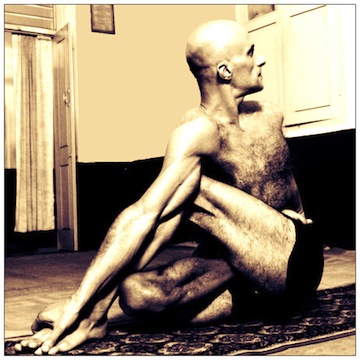1st Annual Ashtanga Yoga Adventure Retreat
with Krista Shirley and Elise Espat
at Xinalani Yoga Retreat (Near Puerto Vallarta, Mexico)
September 29 - October 6, 2012
An unforgettable week of Ashtanga Yoga, relaxation, exploration, and adventure.
Connect with like-minded people, immerse yourself in nature, and deepen
your Ashtanga Yoga practice under the guidance of Elise Espat and Krista
Shirley, both infectiously adventurous level 2 authorized teachers by
the Krishna Pattabhi Jois Ashtanga Yoga Institute. This week will open
your eyes and heart to the secrets of abundant living as you find
yourself surrounded with grace, love, happiness, fulfillment,
appreciation, humility, gratitude and inspiration towards effort.
Each day begins with traditional Mysore practice with the rest of the
day to be spent as you see fit. Relax on the beach, cozy up with a book,
or participate in a group excursion... Swimming with dolphins, anyone?
Parasailing? Zip lining? Rappelling down waterfalls? (You get the
picture.)
No previous yoga or Ashtanga experience is necessary. Just bring your mat and a willingness to learn.
ABOUT THE TEACHERS
Krista Shirley is a dedicated student and practitioner of
traditional Ashtanga yoga. She travels to Mysore, India each year to
spend time studying at the Krishna Pattabhi Jois Ashtanga Yoga Institute
(KPJAYI). Krista humbly gives thanks to her teachers, Sharath Jois and
Saraswathi Jois, for their guidance and love. "It is a true honor
to study with Sharath and Saraswathi so that my own practice and
teachings may continue to grown on the right path under their tutelage."
Krista is a Level 2 Authorized Ashtanga teacher and founder of The
Yoga Shala in Winter Park, Florida where she teaches traditional
Ashtanga yoga classes in the Mysore method.
Krista’s dedication to her personal yoga practice and the Ashtanga
lineage shine through in her teaching. Her energy is contagious and
inspiring! Krista specializes in providing all her students with a lot
of personal attention. Krista is here to help you begin or advance your
Ashtanga Yoga journey.
Krista will be returning to India and KPJAYI for her eighth trip in January 2013.
Elise Espat is dedicated to the ongoing practice and study of the
traditional Ashtanga yoga method. She is one of the few teachers
worldwide to have received Level 2 Authorization, enabling her to teach
both the primary and intermediate series of Ashtanga yoga. She is a
student of many subjects including Sanskrit, philosophy, and anatomy and
maintains an ongoing practice at the Shri K. Pattabhi Jois Ashtanga
Yoga Institute in Mysore, India with R. Sharath Jois and R. Saraswathi
Jois and in New York with Guy Donahaye. Elise currently lives in New
Mexico where she teaches at the Albuquerque Ashtanga Yoga Shala.
LOCATION
Xinalani Yoga Retreat is an intimate eco-conscious retreat center located on a private beach just south of Puerto Vallarta...
"Xinalani Retreat is about discovery, admiration, love for yoga,
nature, magic, conscious travel, eco-adventure, wellness, serenity and
mindful living. We aim to reveal the beauty of an unknown Mexico and
share with our guests eye-opening vacations that inspire transformation.
We are an Eco Resort. We attempt to minimize our environmental impact.
All guest accommodations have low consumption lights (LEDs) and are
equipped with two outlets to reload cell phones and camera batteries.
Our construction method was extremely organic: no concrete, no land
modification, very little footprint. All guests are provided with
high-end eco-friendly soaps and shampoo. Toilets are low-flow, and all
water is recycled and used to irrigate our gardens. We use natural and
biodegradable cleaning products, we recycle, and compost wherever
possible."
SAMPLE SCHEDULE
7:00-9:00am Mysore Practice
9:00-9:30am Chanting
9:30-11:00am Breakfast
1:30-2:30 Lunch
Optional Group Excursion
5-7pm Lecture, Meditation, Chanting
7:30-8:30pm Dinner
ROOMS
All accommodation options are beachfront, spacious, palm-thatched cabins
floating on stilts. The suites were designed with refined elegance and
built and furnished by local artisans. Their cozy interiors inspire
feelings of calm and serenity. Enjoy the closeness of the natural
elements, the stimulation of the open-air private showers and the
stunning views of Puerto Vallarta and the Pacific Ocean directly from
your terrace.
more information
ACTIVITIES
WATER: Swimming, surfing, snorkeling, dolphins, whales, scuba diving, kayaking, bodyboarding, boating
LAND: Hiking, zip-lining, horses, cooking, spa treatments,
volunteering, visit Yelapa, visit Boca de Tomatlán, donkeys, waterfalls
more information
Everything you wanted to know about Xinalani that wasn't included here
Xinalani Yoga Retreat
FAQs
Flickr

















